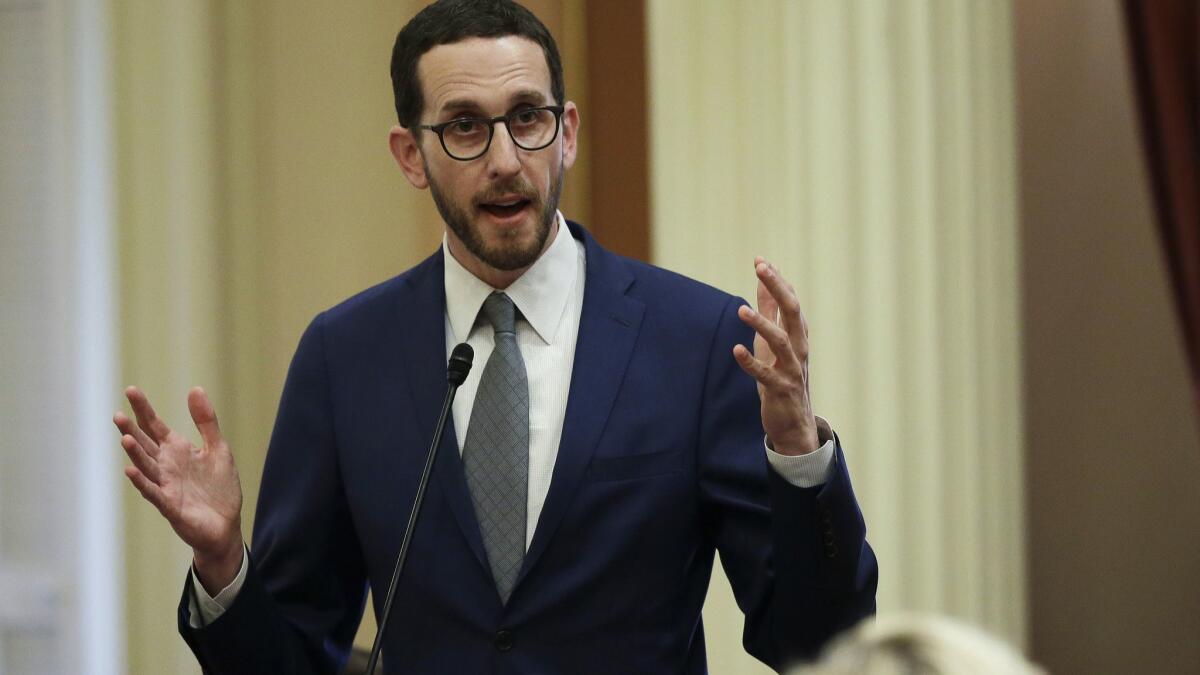California bill to dramatically increase home building fails for the third year in a row

- Share via
SACRAMENTO — After more than two years of debate, five major revisions and two tense days of counting votes, a high-profile legislative effort to dramatically increase home building across California is officially dead.
Senate Bill 50 was an effort to undo California’s decades-long reliance on single-family housing and suburban sprawl stretching inland by spurring a development boom near transit and job centers. But arguments that the legislation would help reduce the housing shortage at the root of the state’s affordability problems and reduce greenhouse gas emissions from cars met resistance from those who believed the measure took too much power away from local governments and failed to sufficiently address low-income housing needs.
And this week, for the third year in a row, California state senators rejected the measure.
“The supply side of housing production is important. We’ve got to do it,” Sen. Maria Elena Durazo (D-Los Angeles) said during debate on Wednesday. “But then I say, ‘What about affordable housing?’”
SB 50 fell three votes short of passage in the state Senate Wednesday. The following morning, bill author Sen. Scott Wiener (D-San Francisco) brought the measure back up for another try. But despite an attempt by supporters to drum up more backing on the Senate floor, the final vote count remained the same.
The decision comes as a blow to Gov. Gavin Newsom and Senate President Pro Tem Toni Atkins (D-San Diego), who had argued that lawmakers needed to take action to dramatically increase California’s housing supply. After the final vote, Atkins made a commitment to pass major housing legislation in 2020.
“I feel compelled to say — and I think you all know this — this is not the end of the story,” Atkins told her colleagues on the Senate floor. “I want to personally commit to each and every one of you, to the people of California, that a housing production bill to help alleviate our housing crisis will happen this year.”
In a statement following the decision, Newsom echoed Atkins’ promise.
“California’s housing affordability crisis demands our state pass a historic housing production bill,” the governor said.
But future efforts are certain to face the same tangled politics that ensnared SB 50 over the past two years.
The legislation would have allowed for the construction of mid-rise apartment complexes near transit and job centers and fourplexes in most single-family neighborhoods throughout the state. Wiener introduced the first iteration of the bill in 2018, contending that the state needed to force local governments to allow more housing to help control the cost of living. He said development near mass transit would make it easier for Californians to drive less, something state environmental officials have said is essential for meeting climate change goals.
But that bill died in its first committee hearing amid deep opposition from advocates representing low-income communities who were worried that increased housing production could fuel gentrification.
Last year, Wiener made numerous changes to the bill aimed at addressing those concerns. The measure required housing projects larger than 10 units to contribute funding or space for low-income housing and prohibits developers from demolishing homes on properties where tenants have lived for at least the prior seven years. The senator gained support from several powerful groups representing labor, environmental, developer, business and real estate interests. But the bill was held without a vote in a committee last spring after concerns from suburban homeowner activists about changes to their communities.
Earlier this month, Wiener announced he was trying again, changing the bill so that local governments would have two years to develop alternative development blueprints before the rules in SB 50 would take effect. Because the bill was held in a Senate committee last year, SB 50 faced a legislative deadline of the end of this month to advance out of the full Senate.
On the Senate floor Wednesday, Wiener argued that his colleagues should allow him to continue discussions over the issue, which he said required a response commensurate with the breadth of the state’s housing problems.
“SB 50 will help plant the seeds so that in the future our kids and our grandkids don’t have to have the same pain that people are experiencing today,” Wiener said.
But the changes made this month didn’t persuade lawmakers. Support for and opposition to SB 50 didn’t fall neatly along partisan or ideological lines. Nearly half of the 29 Democrats in the Senate voted against the bill or abstained from voting. Three out of 10 Republicans voted in favor. But there was a clear divide between lawmakers from the Los Angeles area, the state’s most populous region, and those from other parts of California.
Last week, a coalition of groups representing low-income communities announced their opposition to the bill, including Alliance for Community Transit-Los Angeles, an organization behind a plan to increase density near transit in the city and one that Wiener had been courting for nearly 18 months. And one by one, Democratic state senators from the Los Angeles area began telling their constituents they were opposed.
Ultimately, nine L.A.-area senators voted no or abstained on SB 50, and only one voted yes. Like Durazo, some L.A. legislators cited concerns about gentrification and displacement. Others, including Sen. Bob Hertzberg (D-Van Nuys), said the bill wrongfully targeted local government officials and single-family homeowners in its attempt to help remedy the state’s housing problems.
“There may be some merit to this notion in limited circumstances, [but] this sweeping generalization both oversimplifies the problem and unnecessarily demeans people who have done nothing more than make homes for themselves, raise a family and play by the rules,” Hertzberg said.
The failure of the bill will hinder Newsom’s efforts to speed housing production in the state. On the campaign trail, the governor pledged to increase annual home building nearly fivefold to levels unseen since at least the mid-1950s. The governor has not yet put forward a plan to increase development to the scale he promised.
Newsom never endorsed SB 50, but made some efforts to persuade lawmakers to keep the measure moving forward. When SB 50 was held last year, Newsom said he was “disappointed” that the bill had not advanced and said he was going to get more involved in discussions about the legislation.
In mid-January, top aides to Newsom met with Wiener and suggested amendments to SB 50 that the lawmaker declined to accept, according to multiple sources in the Capitol. Wiener declined to comment on his discussions with the governor’s office.
After Wiener’s bill came up a handful of votes short on Wednesday, representatives of the governor’s office attempted to persuade two Democratic senators to vote for the legislation. But Sen. Bill Dodd (D-Napa) left the meeting and voted against it, saying that legislators still had time this year to introduce an alternative measure. Sen. Tom Umberg (D-Santa Ana) abstained from casting a vote. He said he supported higher-density development around train stations, but worried about how the bill would encourage growth in single-family neighborhoods away from transit.
“The challenge here,” Umberg said, “is that I do support the concept.”
More to Read
Sign up for Essential California
The most important California stories and recommendations in your inbox every morning.
You may occasionally receive promotional content from the Los Angeles Times.












